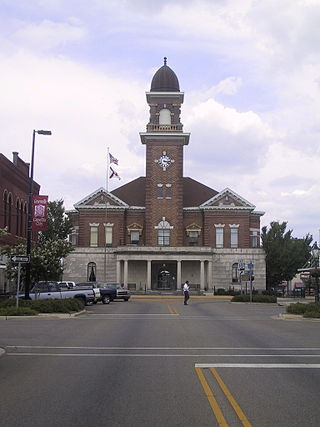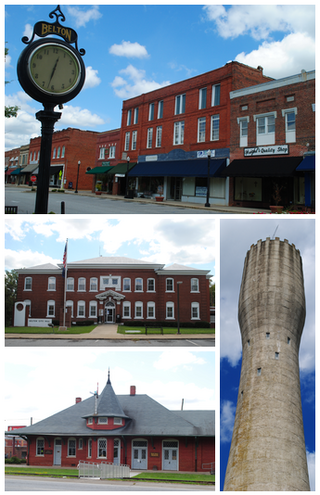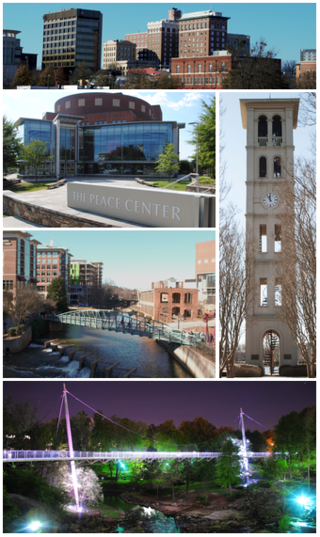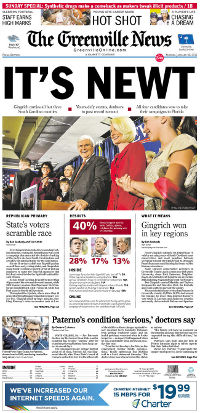Related Research Articles

Bond County is a county located in the U.S. state of Illinois. As of the 2020 census, the population was 16,725. Its county seat is Greenville.

Greenville is a city and the county seat of Butler County, Alabama, United States. At the 2020 census, the population was 7,374. Greenville is known as the Camellia City, wherein originated the movement to change the official Alabama state flower from the goldenrod to the camellia with legislative sponsors LaMont Glass and H.B. Taylor.

Greenville is a borough with home rule status in northwestern Mercer County, Pennsylvania, United States. Located along the Shenango River, it lies roughly 80 miles from both Pittsburgh and Cleveland. It is 1.89 square miles in area, and had a population of 5,541 as of the 2020 census.

Belton is a city in eastern Anderson County, South Carolina. The population was 4,134 at the 2010 census.

Greenville is a city in and the county seat of Greenville County, South Carolina, United States. With a population of 70,720 at the 2020 census, it is the 6th most populous city in the state. Greenville is located approximately halfway between Atlanta, Georgia, and Charlotte, North Carolina, along Interstate 85. Its metropolitan area also includes Interstates 185 and 385. Greenville is the anchor city of the Upstate, a combined statistical area with a population of 1,487,610 at the 2020 census. Greenville was the fourth fastest-growing city in the United States between 2015 and 2016, according to the U.S. Census Bureau.

The Greenville News is a daily morning newspaper published in Greenville, South Carolina. After The State in Columbia and Charleston's The Post and Courier, it is the third largest paper in South Carolina.
The Augusta and Knoxville Railroad (A&K) was a railroad company that operated on 66 miles (106 km) of track between Augusta, Georgia, and Greenwood, South Carolina, from 1882 to 1886. It was merged with three other companies to form the Port Royal and Western Carolina Railway, which was reorganized in 1896 as the Charleston and Western Carolina Railway.
The Blue Ridge Railway was a 19th-century railroad in the U.S. state of South Carolina. It was originally chartered in 1852 as the Blue Ridge Railroad of South Carolina. Original plans were for a 195-mile line from Anderson, South Carolina, to Knoxville, Tennessee going through the mountains with as many as 13 tunnels including the incomplete Stumphouse Mountain Tunnel.
The Detroit, Lansing and Northern Railroad (DL&N) is a defunct railroad which was formed on December 27, 1876 as a reorganization of the foreclosed Detroit, Lansing and Lake Michigan Rail Road. The segment of its main line from Detroit to Lansing became an important component of the Pere Marquette Railroad, organized in 1900, and is still in use by CSX.

West End is a neighborhood in Greenville, South Carolina. Located across the Reedy River in downtown, the west end became home to Furman University when it was first established in 1852. The school expanded to fill fifty acres and then moved to its current location northwest of the city in 1958. The Greenville and Columbia Railroad arrived there in 1853, bringing increased commercial activity to the neighborhood that had been first settled in the 1830s.
The Greenville and Columbia Railroad was a 5 ft gauge railroad that served South Carolina in the 19th century.
The Spartanburg, Union and Columbia Railroad was a successor railroad to the Spartanburg and Union Railroad.
The Port Royal and Augusta Railway was a South Carolina railroad that existed in the latter half of the 19th century.
The Port Royal and Western Carolina Railway (PR&WC) was a railroad company in the southern United States that operated on 229 miles (369 km) of 4 ft 9 in gauge track. It was formed in 1886 by the merger of the Augusta and Knoxville Railroad, Greenwood, Laurens and Spartanburg Railroad, Savannah Valley Railroad and the Greenville and Laurens Railroad, which then joined with Port Royal and Augusta Railway.
The Atlantic, Greenville and Western Railway was a railroad company chartered by the South Carolina General Assembly in 1885.
The Augusta, Knoxville and Greenwood Railroad (AK&G) was a South Carolina railroad company chartered shortly after the end of the Reconstruction period.

The 1919 Clemson Tigers football team represented Clemson Agricultural College—now known as Clemson University—as a member of the Southern Intercollegiate Athletic Association (SIAA) during the 1919 college football season. Under third-year head coach Edward Donahue, the team posted an overall record of 6–2–2 with a mark of 3–2–2 in SIAA play. Stumpy Banks was the team captain.
The 1913 Furman Baptists football team represented Furman University as an independent during the 1913 college football season. Led by Cuppy Farmer in his first and only season as head coach, Furman compiled a record of 6–3.
The 1972 South Carolina Gamecocks football team represented the University of South Carolina as an independent in the 1972 NCAA University Division football season. Led by seventh-year head coach Paul Dietzel, the Gamecocks compiled a record of 4–7. The team played home games at Williams–Brice Stadium in Columbia, South Carolina.
The 1944 South Carolina Gamecocks football team was an American football team that represented the University of South Carolina as a member of the Southern Conference (SoCon) during the 1944 college football season. In their first and only season under head coach Williams Newton, the Gamecocks compiled an overall record of 3–4–2 with a mark of 1–3 in conference play, placing seventh in the SoCon.
References
- ↑ The Days They Changed the Gauge [ unreliable source? ]
- 1 2 Henry Poor (1889). Poor's Manual of the Railroads of the United States. Vol. 22. p. 616 – via Google Books.